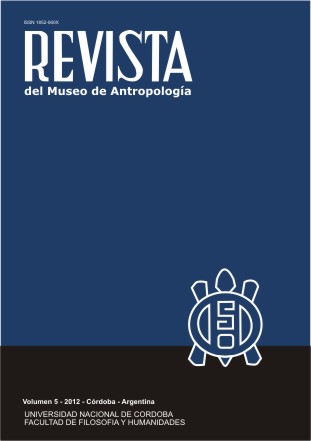Folklore representation policies in folk museums
DOI:
https://doi.org/10.31048/1852.4826.v5.n1.9130Keywords:
museum, folklore, politics, museography, identityAbstract
This work deals with the creation and re-creation of folk museums. It analyzes the political purposes served and reasons put forward, and the agents responsible for their emergence. It also examines whether they have been the result of state institutions or movements arising from elite or minority groups that belong to the civil society. Simultaneously, it is explained how folklore representations are reconceptualized in the representation of the local, regional, national and transnational collective identities. It analyzes a) the current museum guidelines based on internal and external decolonization processes, and their economic, political, social and cognitive implications; b) the critiques of colonial and classist analyses developed in the past by Ethnology and Folklore -disciplines that influenced museographic discourse; and c) the review of the definition of museum as an institution.Downloads
References
Aronsson, P. 2008. The Image of the Peasant within National Museums in the Nordic countries. Societal Change And Ideological Formation among the Rural Population of the Baltic Area 1880-1939, Huddinge: Södertörns högskola: 187-212.
Bauman, R. 2000. “Actuación mediacional y la “autoría” del discurso. Patrimonio Cultural y Comunicación, Museo de Motivos Argentinos J. Hernández: 31-49. (Traducción: Fernando Fischman).
Bennett, T. 1990. The Political Rationality of the Museum Continuum: The Australian Journal of Media & Culture 3(1):35-55.
Bogaart, N. 1983. Hacia nuevos criterios. Museum Museos etnográficos: principios y problema 139: XXXV(3): 145
Burke, P. 1977. Popular Culture in Norway and Sweden1 History Workshop J:1:. 143-150.
Carretero Pérez, A. 2007. Museo del Traje: breve presentación. http://museodeltraje.mcu.es/popups/publicaciones-electronicas/2007-indumenta0/Indumenta00-01-ACP.pdf (Ultima consulta 12-7-2011)
Carretero Pérez, A. 1996. Antropólogos y museos etnográficos. Complutum Extra, 6 (11): 329-336
Cefai, D. 2003. L’enquete de terrain. Paris, La Decouverte Colección Recherches
Clifford, J. (1988. Dilemas de la Cultura Barcelona, Gedisa editorial. Gómez Pedro, A. 2001. Imaginarios sociales y análisis semiótico. Una aproximación a la construcción narrativa de la realidad. Cuadernos FHYCS-UNJU 17: 195-209
Fiskesjö, M. 2007. The Trouble with World Culture Anthropology Today 23 (5):6-11
Götz, N. 2008. Nordic Identities and Asymmetries Nordplus-Infoseminar, Tartu, 8 February.
Hall, S. 1993. “La hegemonía audiovisual“ Silvia Delfino comp. La mirada oblicua. Estudios culturales y democracia. Buenos Aires, La marea pp..86-92.
Langdon, E.J 2007. Performance e sua Diversidade como Paradigma Analítico: A Contribuicao da Abordagem de Bauman e Briggs Antropologia em Primeira Mao pp.5-26 Ministerio de Instrucción Pública y Bellas Artes 1935. “Circular general y cuestionario para la recogida de objetos”. Anales del Museo del Pueblo Español, 1:33-47.
Ministerio de Instrucción Pública y Bellas Artes 1935. Decreto Fundacional Anales del Museo del Pueblo Español 1: 5-10 (edición facsímil en 1988) http://museodeltraje.mcu.es/popups/publicaciones/decreto.htm 2007 (Ultima consultada 12 de julio 2011)
Hernández Hernández, F. 1992. Evolución del concepto de museo Revista General de Información y Documentación, 2: (1): 85-97 http://revistas.ucm.es/byd/11321873/articulos/RGID9292120085A.PDF (Ultima consulta 12-7-2011).
Hillstrom, M. 2010. Contested boundaries: Nation, People and Cultural History Museums in Sweden and Norway 1862-1909 Culture Unbound 2 : 583-607
Karp, I. S. D. Lavine, Eds 1991. Exhibiting Cultures: The Poetics and Politics of Museum Display. Smithsonian Institution Press
Konaré Alpha, O. 1983. Hacia un nuevo tipo de museo “etnográfico” en Africa Museum Museos etnográficos: principios y problema 139, XXXV(3): 246-150
Martínez Zuccardi, S. 2010. La literatura del Noroeste argentino. El grupo “La Carpa” y la conciencia poética en la región Anclajes Posiciones y polémicas en la literatura del Noroeste argentino XIV: 14 pp. 145-163
Maure, M. 1993. Nation, paysan et musée. La naissance des musées d’ethnographie dans les pays scandinaves (1870-1904. Terrain 20 :147-157
Mellado García, A. 2008. Las escritoras del renacimiento literario Occitano del siglo XIX Revista electrónica de Estudios Filológicos 15 http://www.tonosdigital.com/ojs/index.php/tonos/article/view/206/166 (Ultima consulta 12-7-2011)
Millán de Palavecino, D. 1957. Memoria Anual del Museo Folklórico del Noroeste Manuel Belgrano y del Instituto de Investigaciones Folklóricas, San Miguel de Tucumán, Ministerio de Gobierno de Justicia e Instrucción Pública.
Mignolo, W. 2009. La colonialidad: la cara oculta de la modernidad. http://www.macba.es/PDFs/walter_mignolo_modernologies_cas.pdf
Ortiz García, C. 1984. La Obra Antropológica de Don Luis De Hoyos Sainz. Actas de las 2as Jornadas de Etnología de Castilla La Mancha, 1984: 17-32 digital.csic.es/bitstream/10261/13161/1/20090522085857614.pdf – (Ultima consulta 12-7-2011)
Palavecino, E. 1959. Áreas de cultura folklórica en el territorio argentino Folklore Argentino. Buenos Aires, Nova: 347-370
Roigé I Ventura, X., E. Fernández De Paz, I. Arrieta Uurtizberea 2007. El futuro de los museos etnológicos. Consideraciones introductorias para un debate Universidad del País Vasco/Euskal Herriko Unibertsitatea Roigé i Ventura, X. 2007. “La reinvención del museo etnológico” I. Arrieta Urtizberea ed. Patrimonios culturales y museos: más allá de la historia y del arte, Leioa, UPV Servicio editorial: 19-44.
Segalen, M. 2005. Vie d’un musée, 1937-2005 Paris, Stock, 341 p.
Stocking, G. W. 1985. Objects and Others. Essays on Museums and Material Culture History of Anthropology 3 University of Wisconsin Press
Van Ginkel, R. y B. Henkes. 2003. On Peasants and primitive Peoples’: Moments of Rapprochement and Distance between Folklore Studies and Anthropology in the Netherlands Ethnos 68 (1):112-134
Downloads
Published
Issue
Section
License
Those authors who have publications with this Journalaccept the following terms:
a. Authors will retain their copyrights and guarantee the journal the right of first publication of their work, which will be simultaneously subject to the Creative Commons Attribution License (Licencia de reconocimiento de Creative Commons) that allows third parties to share the work as long as its author and his first publication in this journal.
b. Authors may adopt other non-exclusive licensing agreements for the distribution of the version of the published work (eg, deposit it in an institutional electronic file or publish it in a monographic volume) provided that the initial publication in this journal is indicated.
c. Authors are allowed and recommended to disseminate their work on the Internet (eg in institutional telematic archives or on their website) before and during the submission process, which can lead to interesting exchanges and increase citations of the published work. (See The Effect of Open Access - El efecto del acceso abierto)












